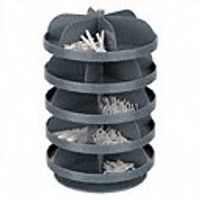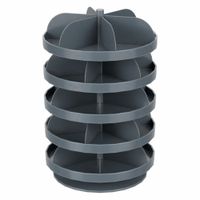Call +(254) 703 030 000 / 751 483 999 / 721 704 777
- Home
- Material Handling
- Storage Workspace
- Bin Compartmented Storage Units
.....Read More
Frequently Asked Questions
What are the benefits of using bin shelving and compartmented storage units?
Bin shelving and compartmented storage units offer several benefits that enhance organization, efficiency, and space utilization in various settings:
1. **Maximized Space Utilization**: These storage solutions optimize vertical and horizontal space, allowing for more items to be stored in a given area. This is particularly beneficial in warehouses, workshops, and retail environments where space is at a premium.
2. **Improved Organization**: By providing designated spaces for different items, bin shelving and compartmented units help maintain order. This organization reduces clutter and makes it easier to locate items quickly, enhancing productivity.
3. **Enhanced Accessibility**: Items stored in bins and compartments are easier to access and retrieve. This reduces the time spent searching for items, thereby increasing operational efficiency and reducing downtime.
4. **Inventory Management**: These storage systems facilitate better inventory control by allowing for easy monitoring of stock levels. Clear bins or labeled compartments make it simple to conduct visual checks, ensuring timely restocking and reducing the risk of overstocking or stockouts.
5. **Versatility and Customization**: Bin shelving and compartmented units are highly versatile and can be customized to fit specific needs. They can accommodate a wide range of items, from small parts to larger tools, and can be reconfigured as storage needs change.
6. **Durability and Protection**: Made from robust materials, these storage units protect items from damage, dust, and environmental factors. This durability ensures a longer lifespan for both the storage units and the items stored within them.
7. **Cost-Effectiveness**: By improving space utilization and reducing the need for additional storage facilities, these systems can lead to significant cost savings. They also minimize losses from misplaced or damaged items.
Overall, bin shelving and compartmented storage units are essential for efficient storage management, offering a practical solution to organize, protect, and access items effectively.
How do revolving storage bins work?
Revolving storage bins, also known as rotary storage systems, operate on a carousel mechanism that allows for efficient storage and retrieval of items. These systems are designed to maximize space utilization and improve accessibility in various settings, such as warehouses, retail environments, and manufacturing facilities.
The core component of a revolving storage bin is a series of shelves or bins mounted on a rotating frame or carousel. This frame is typically powered by an electric motor, which enables the entire assembly to rotate around a central axis. Users can control the rotation through a control panel or automated system, allowing them to bring the desired shelf or bin to a convenient access point.
The rotation can be either horizontal or vertical, depending on the design and application. Horizontal carousels are often used for storing small parts or tools, while vertical carousels are ideal for larger items or documents. Vertical systems are particularly advantageous in utilizing vertical space, making them suitable for environments with limited floor space.
Revolving storage bins enhance efficiency by reducing the time and effort required to locate and retrieve items. They minimize the need for manual searching and walking, as the system delivers the item directly to the user. This not only speeds up operations but also reduces the risk of errors and improves inventory management.
Additionally, these systems can be integrated with inventory management software, allowing for real-time tracking and automated inventory updates. This integration further streamlines operations and ensures accurate stock levels.
Overall, revolving storage bins offer a practical solution for optimizing storage space, improving accessibility, and enhancing operational efficiency in various industries.
What materials are commonly used for these storage units?
Storage units are typically constructed using a variety of materials, each chosen for its specific properties that contribute to the durability, security, and functionality of the unit. Common materials include:
1. **Steel**: Widely used for its strength and durability, steel is often employed in the construction of the walls, doors, and roofs of storage units. It provides excellent protection against weather and potential break-ins.
2. **Aluminum**: Known for being lightweight and resistant to rust, aluminum is sometimes used for the roofing and siding of storage units. It is less durable than steel but offers good protection against corrosion.
3. **Wood**: Often used in the framing and interior structures of storage units, wood provides a cost-effective and versatile option. It is typically treated to resist pests and moisture.
4. **Concrete**: Used for the foundation and sometimes the walls, concrete offers excellent strength and security. It is fire-resistant and provides good insulation against temperature fluctuations.
5. **Vinyl**: Employed as a siding material, vinyl is valued for its low maintenance and resistance to weathering. It is often used in combination with other materials to enhance the aesthetic appeal of storage units.
6. **Fiberglass**: Occasionally used for roofing or siding, fiberglass is lightweight and resistant to corrosion. It is less common but offers good insulation properties.
7. **Plastic**: Used primarily for portable or temporary storage units, plastic is lightweight and resistant to moisture. It is not as durable as metal or wood but offers a quick and easy setup.
These materials are often combined to optimize the storage unit's performance, balancing cost, durability, and environmental resistance.
How do I choose the right size and type of storage unit for my needs?
To choose the right size and type of storage unit, follow these steps:
1. **Inventory Assessment**: List all items you plan to store. Categorize them by size and fragility to understand space requirements and special needs.
2. **Size Estimation**:
- **5x5 Unit**: Suitable for small items, boxes, or seasonal decorations.
- **5x10 Unit**: Fits the contents of a small room, like a studio apartment.
- **10x10 Unit**: Accommodates the contents of a one-bedroom apartment.
- **10x15 Unit**: Ideal for a two-bedroom apartment or small house.
- **10x20 Unit**: Can store the contents of a three-bedroom house.
- **10x30 Unit**: Suitable for larger homes or vehicles.
3. **Type of Storage**:
- **Climate-Controlled**: Necessary for sensitive items like electronics, artwork, or documents to protect against temperature and humidity fluctuations.
- **Drive-Up Access**: Convenient for heavy or bulky items, allowing easy loading and unloading.
- **Indoor Units**: Offer added security and protection from the elements, suitable for valuable or delicate items.
- **Outdoor Units**: Typically used for vehicles or items not sensitive to weather conditions.
4. **Duration and Accessibility**: Consider how often you need to access your items. Frequent access may require a unit closer to the entrance or with extended hours.
5. **Budget Considerations**: Balance your needs with your budget. Larger or specialized units cost more, so choose the smallest size that fits your requirements.
6. **Visit Facilities**: If possible, visit storage facilities to assess cleanliness, security, and customer service.
7. **Future Needs**: Consider potential future storage needs to avoid frequent changes.
By evaluating these factors, you can select a storage unit that efficiently meets your needs.
Can these storage units be customized or expanded?
Yes, storage units can often be customized or expanded, depending on the type and provider. Many storage facilities offer a range of unit sizes to accommodate different needs, and some allow for customization in terms of shelving, climate control, and security features. Modular storage units, such as portable containers, can be expanded by adding additional units or sections. Some facilities may also offer flexible leasing options, allowing you to upgrade to a larger unit as your storage needs grow. However, the extent of customization and expansion options can vary, so it's important to check with the specific provider for their policies and capabilities.
What are the best practices for organizing items in these storage units?
1. **Categorize Items**: Group similar items together. For example, keep all kitchenware in one section and tools in another.
2. **Label Everything**: Use clear, visible labels on boxes and shelves to easily identify contents without opening them.
3. **Use Clear Bins**: Opt for transparent storage bins to quickly see what's inside, reducing the need to rummage through boxes.
4. **Prioritize Accessibility**: Place frequently used items at the front or top for easy access, and less-used items towards the back or bottom.
5. **Maximize Vertical Space**: Use shelving units to take advantage of vertical space, keeping the floor area clear and organized.
6. **Create Aisles**: Leave space between rows of boxes or shelves to allow easy movement and access to all items.
7. **Use Uniform Boxes**: Choose boxes of the same size for easy stacking and to maximize space efficiency.
8. **Protect Fragile Items**: Wrap delicate items in bubble wrap or packing paper and store them in sturdy boxes.
9. **Inventory List**: Maintain a detailed inventory list of all items and their locations within the storage unit for quick reference.
10. **Climate Control**: If possible, use climate-controlled units for sensitive items like electronics, documents, or antiques to prevent damage from temperature fluctuations.
11. **Use Pallets**: Keep items off the ground using pallets to protect against potential water damage.
12. **Disassemble Large Items**: Break down large furniture or equipment to save space and make them easier to store.
13. **Utilize Corners**: Store bulky or less-used items in corners to free up central space for more accessible storage.
14. **Regular Maintenance**: Periodically review and reorganize the storage unit to ensure it remains efficient and clutter-free.
How do I maintain and clean these storage units?
1. **Regular Inspection**: Schedule routine checks to identify any signs of damage, leaks, or pest infestations. Early detection can prevent larger issues.
2. **Climate Control**: Ensure climate-controlled units are functioning properly to prevent mold, mildew, and damage to sensitive items. Check humidity levels and temperature settings regularly.
3. **Pest Control**: Implement a pest control plan. Use traps and repellents, and seal any gaps or cracks to prevent entry. Regularly inspect for signs of pests.
4. **Cleaning Schedule**: Establish a regular cleaning routine. Sweep and mop floors, dust surfaces, and clean windows. Use appropriate cleaning agents for different materials.
5. **Declutter**: Periodically declutter the unit. Remove unnecessary items to maintain organization and prevent overcrowding, which can lead to damage.
6. **Proper Ventilation**: Ensure units are well-ventilated to prevent moisture buildup. Use dehumidifiers if necessary.
7. **Labeling and Organization**: Clearly label boxes and maintain an inventory list. Use shelving to keep items off the floor and organized.
8. **Security Measures**: Regularly check locks and security systems. Ensure cameras and alarms are functioning properly to protect stored items.
9. **Maintenance of Doors and Locks**: Lubricate door hinges and locks to ensure smooth operation. Replace any faulty components immediately.
10. **Floor Protection**: Use pallets or mats to keep items off the floor, protecting them from potential water damage.
11. **Professional Services**: Consider hiring professional cleaning and maintenance services for thorough upkeep, especially for large or complex units.
12. **Customer Communication**: If managing a storage facility, maintain open communication with customers about their responsibilities in maintaining their units. Provide guidelines and support as needed.



